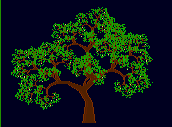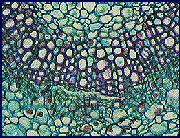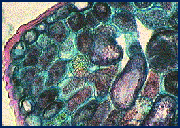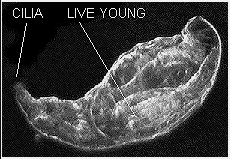
The festive fun is over for another year, so why not join me for a bracing walk in the countryside to study nature in close-up, and perhaps collect some specimens for the microscope to keep you busy in those long winter evenings! This month we will have a closer look at some evergreen leaves, get to grips with mosses, and dip into your birdbath or garden pond.
Before you put your boots on, please read the important notes on collecting.
 Although the deciduous trees are looking very stark at present, the evergreens
such as the conifers are still providing some welcome colour to the countryside.
In the past, like me, you may have passed them by without a second glance.
So why not take a closer look at them with your hand lens to see how each
conifer species differs in the way the needles are arranged on the branches.
Although the deciduous trees are looking very stark at present, the evergreens
such as the conifers are still providing some welcome colour to the countryside.
In the past, like me, you may have passed them by without a second glance.
So why not take a closer look at them with your hand lens to see how each
conifer species differs in the way the needles are arranged on the branches.
In the Silver Fir Abies alba, the leaves are single, silvery underneath and with a groove. Each needle is stalkless, and when pulled away from the branch it leaves a neat round scar. In contrast, the Douglas Fir Pseudotsuga menziesii leaves round raised scars when the needle is pulled from the branch.
In the Pine Pinus family of conifers the needles are arranged in twos (eg Scots Pine P.sylvestris), threes (eg Ponderosa Pine P.ponderosa) or even fives (eg White Pine P.strobus).
 An evergreen commonly seen in English churchyards is the Yew Taxus baccata.
This has dark green and broader leaves than the conifers above and are
arranged in two rows. Note that the leaves, bark and seeds are poisonous
to man. Yews can grow to a great age. In Surrey, England there is a yew
45 feet in diameter with an estimated age of 2500 years.
An evergreen commonly seen in English churchyards is the Yew Taxus baccata.
This has dark green and broader leaves than the conifers above and are
arranged in two rows. Note that the leaves, bark and seeds are poisonous
to man. Yews can grow to a great age. In Surrey, England there is a yew
45 feet in diameter with an estimated age of 2500 years.
In urban areas, particularly the UK, privet Ligustrum is commonly grown as an ornamental hedge. The privet although a half-evergreen is not a conifer, but a member of the Olive Oleaceae family ie it has a true flower rather than cones.
If you like a challenge and have access to sectioning facilities eg a bench microtome, the cross sections of evergreens can be very attractive. The left and righthand images shown are stained cross sections of privet and yew respectively prepared by the author on a course for amateurs.
Rotifers, colloquially known as wheel animalcules, have delighted microscopists over the years because of their wonderful variety of form. Despite being microscopic, they are multicellular with jaws, eye spots and other organs. They vary in size from about 40-2000um, the females being larger than the male. The characteristic feature of rotifers is the crown of cilia, which in some species resembles the escapement wheel of a watch. The name of the phylum Rotifera is derived from the Latin rota a wheel and fero to bear.
 Scrape some sediment from the bird bath, allow to settle in some water
and study the sample under a low magnification. The most common type of
rotifer found in these habitats is usually the bdelloid type, which moves
somewhat like a leech. An image of this type of rotifer is shown on the
left using dark ground illumination. It is about 500um (0.5mm) in length,
therefore it can just be made out by the naked eye as a white spot. The
species shown is carrying live young, although most rotifers release eggs.
Scrape some sediment from the bird bath, allow to settle in some water
and study the sample under a low magnification. The most common type of
rotifer found in these habitats is usually the bdelloid type, which moves
somewhat like a leech. An image of this type of rotifer is shown on the
left using dark ground illumination. It is about 500um (0.5mm) in length,
therefore it can just be made out by the naked eye as a white spot. The
species shown is carrying live young, although most rotifers release eggs.
Study how the rotifers move and feed under low power, before transferring a rotifer with some water to a slide and covering carefully with a supported cover-glass eg use a few specks of vaseline as a support to prevent crushing the organism. If possible, compare the features of the rotifer with an annotated diagram of the rotifers' structure from a good zoology textbook.
Footnote
Eric Hollowday, a well known UK microscopist and expert on rotifers,
has kindly provided some comments on the rotifer section.
The red encrustation found in dried out birdbaths and similar receptacles
consist of cysts of the alga Sphaerella or Haematococcus.
The 'tun' or dried out Philodina roseola tend to be more of a pinky-brown
colour, the deeper red to rust tinge being the Sphaerella cysts.
Also, with one or two isolated exceptions, it is now generally excepted
that bdelloid rotifers do not actually 'encyst' - they just dry out in
the outer layers and then readsorb moisture when the water returns.
Trees and leaf structure
The naturalist is usually spoilt for choice for books on tree identification,
consult your local library or bookshop. Introductory texts on botany and
the large encyclopaedias should both give a good introduction to leaf structure.
One of the definitive guides for the UK is given below.
A Field Guide to the Trees of Britain and Northern Europe by A Mitchell, Collins, London 1976. 414 pages. ISBN 0 00 219213 6.
Rotifers
Rotifers by J Donner. F Warne & Co., London 1966. 80 pages.
An excellent introduction to these organisms, with beautiful line drawings.
Out of print but should be still available.
A Key to the British Freshwater Planktonic Rotifera by R M Pontin.
Freshwater Biological Association (FBA) Publication No 38, 1978. 178 pages.
(Available from The Librarian, FBA, Ferry House, Ambleside, Cumbria LA22
0LP, UK). SBN 900386 33 9, ISSN 0367-1887. A well illustrated guide to
the identification of the UK planktonic species.
A longer list of suggested reading for non-flowering plants was given last month.
If you are interested in preparing slides of leaf sections or other botanical and zoological specimens, courses are available for the amateur in the UK. (Check out the Vendors section on the front page). Prepared slides of botanical and other subjects are also available from the sources listed.
If you don't live in the UK, check with your local library, college or tourist office about evening classes, residential courses etc.
Comments to Dave Walker